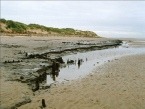The Development of Formby
Reg Yorke – 13 August 2006

It is known that Formby was populated, at least seasonally, during the pre-historic period as recent archaeological work has shown that human footprints in the silt of the inter tidal zone were formed 4000 – 3500 years ago. Formby is a place-name of Norse origin which relates to settlement of the area probably by Vikings from Ireland in the 10th century AD, and it is likely that Formby has been occupied fairly continuously from a very early period. It is thought that the Formby Channel, now silted up, and the mouth of the Alt, provided easy seaward access and a safe haven for small ships, in contrast to the rather more difficult access across the treacherous mosses to the East.
In the mediaeval period Formby was a Chapeiry, a detached portion of the Parish of Walton-on-the-Hill, within West Derby Hundred. The ancient Chapel already existing by the 12th century, stood in the old churchyard which still surrounds St Lukes Church. The area originally included Ainsdale as well as Ravenmeols, but Ainsdale split off in 1905. These settlements were all established prior to 1086 when Formby was recorded as having been possessed by three (un-named) Thanes, but even then paying taxes in the form of Dane-geld!
Indeed there is a tradition that troops for the suppression of rebellion in 1715 were embarked here for Scotland and that early in the eighteenth century a proposal was made for the construction of an enclosed dock here, rather than Liverpool. Certainly our coastal positions has always been important and this was reflected by the construction of a landmark, (later a lighthouse), in 1719. Also Britain’s first Lifeboat station in 1776, an Admiralty coastal Signalling Station during the Napoleonic Wars and the North-West Coast Guard HQ from 1949 to 1983.
Fishing, formerly important is now only undertaken by a few remaining enthusiasts but like asparagus cultivation, was commercially important in earlier times. After the construction of the Railway in 1848, the character of Formby became more residential, although an attempt to build a Promenade and develop ‘Formby-by-the- Sea on the Ravenmeols coast at the turn of the twentieth century failed, leaving us with one of the longest and most attractive dune coastlines in the country. This is now nationally important for its ecology and wild life interest, and now perhaps particularly famed as one of the few remaining habitats of the red squirrel. Conifer planting, first successfully attempted by the Formby family at Firwood in the late eighteenth century, was later extended by both manorial families and the resulting Pine woodland is now an important component of the Mersey Forest.
Formby had a proud record of service both civic and personal during World War 2. In addition to RAF Woodvale, (now the home of the Liverpool and Manchester University Air Squadrons), it provided a home for the Kings Liverpool Regiment, a association commemorated in the name of one of its two Electoral Districts, ‘Harington’ named after General Sir Charles Harington, GCB, GVE, DSO a former Colonel of that regiment, who dying in 1940, gave his name to the then new Barracks in Formby, the site of which is now covered by a large modem housing estate.
